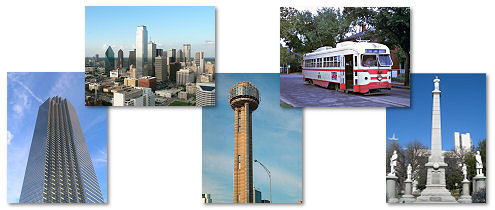
City Maps/Weather
| Fun City Facts The oldest carousel in the United States is located in the resort town of Watch Hill, Rhode Island. Boeing's final assembly plant, the world's largest building, is located in Everett, Washington. |
|
|
||||||||
Dallas, Texas
City History |
||||||||
 Dallas was founded in 1841 and formally incorporated as a city on February 2 1856. The city is well known for its role in the petroleum industry, telecommunications, computer technology, banking, and transportation. It is the core of the largest inland metropolitan area in the United States. Dallas's prominence also comes from its historical importance as a center for the oil and cotton industries, its position along numerous railroad lines, and its powerful industrial and financial tycoons. Dallas was just another small town dotting the Texas frontier until after the American Civil War in which it was part of the Confederate States of America, and only legally became a city in 1871. The city paid the Houston and Central Texas Railroad US$5,000 to shift its route 20 miles to the west and build its north-south tracks through Dallas, rather than through Corsicana as planned. A year later, Dallas leaders could not pay the Texas and Pacific Railroad to locate there, so they devised a way to trick the Railroad. Dallas had a provision attached to a state law which required the railroad to build its tracks through Browder Springs-which turned out to be just south of Main Street. In 1873, the major north-south and east-west Texas railroad routes intersected in Dallas, thus ensuring its future as a commercial center. By the turn of the twentieth century Dallas was the leading drug, book, jewelry, and wholesale liquor market in the Southwestern United States. It also quickly became the center of trade in cotton, grain, and even buffalo. It was the world's leading inland cotton market, and continued to lead the world in manufacture of saddlery and cotton gin machinery. As it further entered the 20th century, Dallas transformed from an agricultural center to a focused center of banking, insurance, and other businesses. Oil was discovered 100 miles east of Dallas and the city quickly became the financial center for the oil industry in Texas. In 1958 the integrated circuit was invented in Dallas by Jack Kilby of Texas Instruments, which punctuated the Dallas area's development as a center for high-technology manufacturing. During the 1950s and 1960s, Dallas became the nation's third-largest technology center, with the growth of such companies as LTV Corporation and Texas Instruments. In 1957 two developers, Trammell Crow and John M. Stemmons, opened a Home Furnishings Mart that grew into the Dallas Market Center, the largest wholesale trade complex in the world. On November 22 1963, President John F. Kennedy was assassinated on Elm Street while his motorcade passed through Dealey Plaza in downtown Dallas. Because of the immense worldwide success of the hit television series Dallas, the city became one of the most internationally recognizable U.S cities during the 1980s. The 1980s also saw many oil industry companies relocate to Houston in order to be closer to offshore operations and the Port of Houston. However, Dallas was beginning to benefit from an escalating technology boom at the same time, driven by the growing computer, microchip and telecommunications industries. The mid-to-late 1980s were very chaotic for the city when many Dallas banks collapsed from the Savings and Loan crisis. The hit effectively threw the city's economy to its knees and plans for hundreds of millions of dollars worth of development were scrapped. The city remained in recession during the 1990s but the explosive growth of technology-based businesses kept the city's economy fairly stable. During the 1990s, Dallas became known as the Silicon Prairie, similar to California's Silicon Valley. Recession continued to plague the city into the early 21st century. From 1988 to 2005, not a single high-rise structure was built within the downtown area. By the mid-2000s, the dried up downtown market began to turn around with the construction of multiple art venues, office towers, residential towers, and residential conversions. Proving Dallas once again to be a thriving industrious American city it's founders new it to be. Today, if you are wondering where to stay in Dallas while you tour the rich history of this city, take a look at our lodging links. |
Historic Figures
John Neely Bryan (1810 –1877)| John Neely Bryan (1810 –1877) | |
| Bryan visited the Dallas area in 1839 looking for a place to create a trading post and work as the postmaster, storeowner and ferry operator. In 1841 he learned that a treaty had forced the Native Americans, his prospective customers, out of North Texas. So instead he established a permanent settlement, which eventually became the budding city of Dallas. | |
browse cities | search | get listed | spotlight | about us | contact us | policies | partners
Copyright ©2024 www.ByCityLight.com - Page Design by Erik Schubach and Tristan Chambers